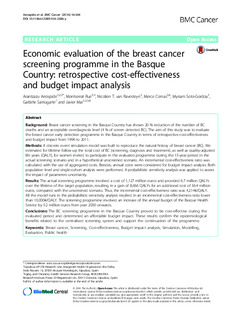| dc.rights.license | Attribution 4.0 International | * |
| dc.contributor.author | Soto-Gordoa, Myriam | |
| dc.contributor.other | Arrospide, Arantzazu | |
| dc.contributor.other | Ravesteyn, Nicolien T. van | |
| dc.contributor.other | Rue, Montserrat | |
| dc.contributor.other | Comas, Merce | |
| dc.contributor.other | Sarriugarte, Garbiñe | |
| dc.contributor.other | Mar, Javier | |
| dc.date.accessioned | 2022-05-12T11:14:40Z | |
| dc.date.available | 2022-05-12T11:14:40Z | |
| dc.date.issued | 2016 | |
| dc.identifier.issn | 1471-2407 | en |
| dc.identifier.other | https://katalogoa.mondragon.edu/janium-bin/janium_login_opac.pl?find&ficha_no=128611 | en |
| dc.identifier.uri | https://hdl.handle.net/20.500.11984/5574 | |
| dc.description.abstract | Background
Breast cancer screening in the Basque Country has shown 20 % reduction of the number of BC deaths and an acceptable overdiagnosis level (4 % of screen detected BC). The aim of this study was to evaluate the breast cancer early detection programme in the Basque Country in terms of retrospective cost-effectiveness and budget impact from 1996 to 2011.
Methods
A discrete event simulation model was built to reproduce the natural history of breast cancer (BC). We estimated for lifetime follow-up the total cost of BC (screening, diagnosis and treatment), as well as quality-adjusted life years (QALY), for women invited to participate in the evaluated programme during the 15-year period in the actual screening scenario and in a hypothetical unscreened scenario. An incremental cost-effectiveness ratio was calculated with the use of aggregated costs. Besides, annual costs were considered for budget impact analysis. Both population level and single-cohort analysis were performed. A probabilistic sensitivity analysis was applied to assess the impact of parameters uncertainty.
Results
The actual screening programme involved a cost of 1,127 million euros and provided 6.7 million QALYs over the lifetime of the target population, resulting in a gain of 8,666 QALYs for an additional cost of 36.4 million euros, compared with the unscreened scenario. Thus, the incremental cost-effectiveness ratio was 4,214€/QALY. All the model runs in the probabilistic sensitivity analysis resulted in an incremental cost-effectiveness ratio lower than 10,000€/QALY. The screening programme involved an increase of the annual budget of the Basque Health Service by 5.2 million euros from year 2000 onwards.
Conclusions
The BC screening programme in the Basque Country proved to be cost-effective during the evaluated period and determined an affordable budget impact. These results confirm the epidemiological benefits related to the centralised screening system and support the continuation of the programme. | en |
| dc.language.iso | eng | en |
| dc.publisher | BioMed Central Ltd | en |
| dc.rights | © 2016 The Author(s) | en |
| dc.rights.uri | http://creativecommons.org/licenses/by/4.0/ | * |
| dc.subject | Breast cancer | en |
| dc.subject | Screening | en |
| dc.subject | Cost-effectiveness | en |
| dc.subject | Budget impact analysis | en |
| dc.subject | simulation | en |
| dc.subject | Modelling | en |
| dc.subject | Evaluation | en |
| dc.subject | Public health | en |
| dc.title | Economic evaluation of the breast cancer screening programme in the Basque Country: retrospective cost-effectiveness and budget impact analysis | en |
| dc.type | http://purl.org/coar/resource_type/c_6501 | |
| dcterms.accessRights | http://purl.org/coar/access_right/c_abf2 | en |
| dcterms.source | BMC Cancer | en |
| local.contributor.group | Innovación, gestión, organización | es |
| local.description.peerreviewed | true | en |
| local.identifier.doi | https://doi.org/10.1186/s12885-016-2386-y | en |
| local.contributor.otherinstitution | Organización Sanitaria Integrada Alto Deba | es |
| local.contributor.otherinstitution | https://ror.org/01a2wsa50 | es |
| local.source.details | Vol. 16 : 344. 1 June, 2016 | |
| oaire.format.mimetype | application/pdf | |
| oaire.file | $DSPACE\assetstore | |
| oaire.resourceType | http://purl.org/coar/resource_type/c_6501 | en |
| oaire.version | http://purl.org/coar/version/c_970fb48d4fbd8a85 | en |








